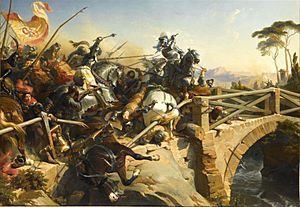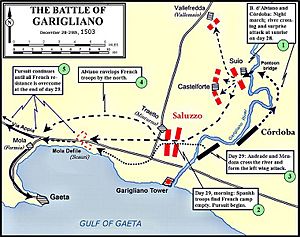Battle of Garigliano (1503) facts for kids
Quick facts for kids Battle of Garigliano |
|||||||
|---|---|---|---|---|---|---|---|
| Part of the Third Italian War | |||||||
 Chevalier de Bayard at the bridge of Garigliano |
|||||||
|
|||||||
| Belligerents | |||||||
| Commanders and leaders | |||||||
| Gonzalo Fernández de Córdoba Bartolomeo d'Alviano |
|||||||
| Strength | |||||||
| 15,000 | 23,000 | ||||||
| Casualties and losses | |||||||
| 900 | 4,000 | ||||||
The Battle of Garigliano was a very important fight that happened on December 29, 1503. It was part of a bigger conflict called the Third Italian War. In this battle, the Spanish army, led by Gonzalo Fernández de Córdoba, fought against the French army. The French forces were commanded by Ludovico II, who was the Marquis of Saluzzo. The battle took place near the Garigliano River in what is now Italy.
Contents
Getting Ready for Battle
In late 1503, the French and Spanish armies were camped on opposite sides of the Garigliano river. This river is about 60 kilometers (around 37 miles) north of Naples. Both armies were in a swampy area, which was not healthy.
The Spanish army tried many times to cross the river using a temporary bridge. But they could not succeed. The French army was set up near the river's mouth, close to the old ruins of Minturnae. They had an advantage because they could easily get supplies from the nearby port of Gaeta.
At first, the Spanish commander, Gonzalo de Córdoba, wasn't sure what to do. He thought about attacking or even retreating. But then, he got more soldiers from Naples. These reinforcements were led by Bartolomeo d'Alviano and Orsini.
With these new troops, Córdoba made a clever plan. He moved some of his soldiers to make the French think he was retreating. He wanted Ludovico to believe he was heading back towards the Volturno river.
Meanwhile, Córdoba secretly built bridges using boats and barrels. He made these bridges at a castle called Mondragone. This castle was about 12 kilometers (7.5 miles) south of the Spanish camp. His goal was to cross the river by surprise.
The Battle Begins
During the night of December 27 and 28, the Spanish moved their bridge-building materials. They took them to a hidden spot near the castle of Suio. This place was about six kilometers (3.7 miles) north of the French camp.
At dawn, the Spanish vanguard, led by d'Alviano, started building the bridges. By 10 AM, about 3,500 Spanish soldiers had already crossed the Garigliano river.
The French had 300 crossbowmen at Suio, but they didn't notice the Spanish crossing. This allowed Gonzalo de Cordoba to cross the river too. He brought 2,000 German pikemen and 200 horsemen led by Prospero Colonna.
Cordoba then ordered an attack on the French bridge. When d'Alviano's troops reached Suio, the French crossbowmen ran away. They fled towards Castelforte, where they met 300 more French soldiers. These soldiers also ran away to Traetto. This allowed d'Alviano to take control of Castelforte. Gonzalo de Cordoba spent that night in Castelforte.
Many French soldiers in their Traetto camp were sick. Because of this, they couldn't send help. A French captain named Alegri decided to destroy their bridge. He ordered a full retreat to Gaeta. They left behind all the sick soldiers and nine cannons in their camp.
French Retreat and Spanish Pursuit
When Gonzalo de Cordoba learned about the French retreat, he decided to keep moving forward. Colonna and his horsemen caught up with the French at Scauri. However, a brave defense of a bridge by Chevalier Bayard helped the French escape safely.
After a few small fights, the French took a position near a bridge in Mola. They were able to push back Colonna's attempt to surround them. But when the rest of the Spanish army arrived, the Marquis of Saluzzo had to order another retreat.
What Happened After
The Spanish victory was a big one. The French army's ability to fight was completely broken. After being surrounded for a few days in Gaeta, the French surrendered.
The remaining French soldiers traveled back to Milan, either by sea or on foot. Many of them died from hunger or were killed by civilians. Even their commander, Ludovico, Marquis of Saluzzo, died when he reached Genoa.
In 1504, a peace agreement called the Treaty of Blois was signed. With this treaty, France agreed that Spain would control Naples.
See also
 In Spanish: Batalla del Garellano (1503) para niños
In Spanish: Batalla del Garellano (1503) para niños


